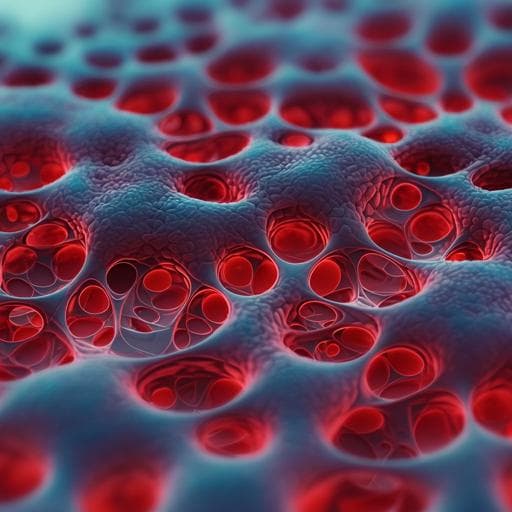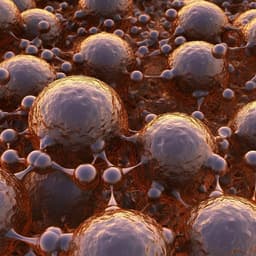
Medicine and Health
Superporous sponge prepared by secondary network compaction with enhanced permeability and mechanical properties for non-compressible hemostasis in pigs
T. Jiang, S. Chen, et al.
Discover how Tianshen Jiang and colleagues have tackled the challenge of developing superporous hemostatic sponges with enhanced permeability and mechanical properties! Their innovative temperature-assisted secondary network compaction strategy results in a sponge that provides rapid hemostasis, superior blood absorption, and fatigue resistance, outpacing current commercial options in pig models. This research paves the way for effective clinical applications.
~3 min • Beginner • English
Introduction
Non-compressible hemorrhage is difficult to control with tourniquets or manual compression and is associated with high mortality. Shape-recoverable hemostatic sponges that absorb blood to expand and exert pressure within deep, narrow wounds are promising, but current porous sponges typically have limited pore interconnectivity and small pore sizes, restricting rapid blood uptake, delaying shape recovery, and impeding cell infiltration and tissue regeneration. Increasing porosity to improve permeability often compromises mechanical strength, undermining the sponge’s ability to maintain pressure. The study aims to develop a chitosan-based hemostatic sponge that simultaneously achieves high liquid permeability and robust mechanical performance to enable rapid shape recovery and sustained compression for effective control of non-compressible bleeding and to support subsequent tissue regeneration.
Literature Review
Prior methods to create porous hemostatic sponges include direct lyophilization and the use of foaming agents to boost liquid diffusion and shape recovery. However, these approaches often generate small pores (10–250 μm), limited porosity (23–80%), restricted interconnectivity, and modest water absorption (5.5–9.5 g/g in 24 h), leading to slower blood uptake and poor tissue ingrowth. Strategies like freeze-casting or directional stretching can compact/densify polymer networks to improve toughness and fatigue resistance with faster shape recovery. Chitosan is widely used for hemostasis due to biocompatibility, biodegradability, antibacterial and pro-coagulant properties; raising pH of acidic chitosan solutions triggers phase separation and physical cross-linking into 3D networks. Yet, phase separation alone yields sponges with low interconnectivity and limited pore size. Thus, the literature highlights a trade-off between permeability and mechanical strength that this work addresses via a temperature-assisted secondary network compaction strategy.
Methodology
Design and fabrication: A temperature-assisted secondary network compaction (TA-2ndNC) process was developed. Step 1: Primary compaction via phase separation—acidic chitosan solution (2.5 wt% in 1.25 wt% acetic acid) is mixed with 0.1 M phosphate buffer containing 0.45 M NaHCO3 (v/v=1:0.7) to deprotonate chitosan, strengthen hydrogen bonding, and induce phase separation. After 30 min, the hydrogel is washed in PBS. Step 2: Temperature-assisted pre-freezing—phase-separated gels are equilibrated to a pre-freeze drying temperature (Tprd) of 0 °C (achieved by -20 °C freezer for 30 min; temperature probed). Step 3: Freeze-drying—lyophilization for 8 h yields superporous chitosan sponge (spCS). Controls: CS (no phase separation; 1.5 wt% solution freeze-dried after flash freezing), PCS (phase-separated gel pre-frozen at -80 °C then freeze-dried), epCS (phase-separated gel pre-frozen at 20 °C then freeze-dried). Surface modification: spCS is alkylated (A-spCS) via dodecanal in DCM followed by reductive amination using sodium triacetoxyborohydride; washing with ethanol/water and re-lyophilization. XPS quantifies grafting (N1s C–NH–C vs C–NH2). Characterization: Micro-CT and density heatmaps assess porosity and backbone density; SEM assesses microstructure and pore morphology; ImageJ measures pore diameters; n-hexane infiltration quantifies porosity. XRD evaluates lattice changes (peak shifts). Absorption and shape recovery: Compressed samples are immersed in water or rat blood; time-resolved mass changes yield absorption capacity (g/g) and rate (g/g/s); time to complete shape recovery is recorded. Mechanical testing: Cylindrical samples (~8 mm diameter) underwent cyclic uniaxial compression to 85% strain at 100 μm/s for 100 cycles; hysteresis and maximum stress retention are computed. Compressive pressure after liquid absorption under 85% strain and shape fixation is measured. Hemostatic assays: Blood Clotting Index (BCI) measured by OD540 after exposure to materials (gauze, GS, CELOX, CELOX-E, CS, PCS, spCS, A-spCS); RBC and platelet adhesion quantified via hemoglobin release and LDH assays, respectively. Antibacterial tests: E. coli, S. aureus, and P. aeruginosa (10^8 CFU/mL) incubated on sterilized materials for 2 h; viable bacteria resuspended, plated, and CFUs counted; log reductions calculated; extended timepoints (4–6 h) and antibiotic-loaded A-spCS assessed. Biocompatibility: Live/dead staining of 3T3 and LX-2 cells; MTT/CCK-8 with A-spCS extracts (10–40 mg/mL) for 1–3 days; hemolysis per ASTM (<5% threshold). In vivo hemostasis: SD rat liver perforation (6 mm defect) treated with materials; blood loss and hemostasis time measured. Minipig (Bama) perforation wounds (18 mm diameter) in liver and spleen treated with CELOX or A-spCS; hemostasis time and blood loss recorded. Regeneration: Rat liver defect model; materials implanted and evaluated at 4 weeks by H&E (tissue ingrowth), DAPI (cell infiltration), immunostaining for vWF (capillaries), ALB (liver parenchymal cells), and HNF-4α (hepatocyte differentiation). In vitro cell migration: NIH 3T3 and LX-2 cell penetration into A-spCS assessed after 5 days by Calcein staining and confocal imaging. Statistics: n=3 unless specified; mean ± SD; t-test or one-way ANOVA with Tukey; p<0.05 significant.
Key Findings
- Structural optimization via TA-2ndNC at Tprd=0 °C yielded spCS with highly interconnected, superporous structure: average pore diameter 1052.0 ± 208.90 μm and porosity 88.42 ± 6.18%.
- Controls: CS (no compaction) had 17.80 ± 8.63 μm pores and 15.77 ± 3.03% porosity; PCS (−80 °C) had 241.8 ± 96.63 μm pores and 23.95 ± 4.22% porosity; epCS (20 °C) had 1648 ± 490.2 μm pores and 90.61 ± 2.84% porosity but low network density (≈52% lower than spCS) due to structural deformation.
- Micro-CT density maps showed spCS backbone density significantly higher than CS and PCS; overall network density of spCS ≈53% higher than PCS.
- XRD: spCS (200/220) reflection shifted ~0.3° to higher 2θ vs PCS, indicating decreased lattice spacing from hydrogen-bond rearrangement during secondary compaction.
- Alkylation (A-spCS) achieved 27.20 ± 3.48% dodecanal grafting (XPS) without altering interconnected morphology (pore 993.8 ± 159.9 μm; porosity 88.02 ± 7.1%).
- Rapid shape recovery: spCS recovered in 0.84 ± 0.13 s (water) and 4.0 ± 1.13 s (blood); A-spCS in 1.07 ± 0.30 s (water) and 4.37 ± 1.36 s (blood). CS and PCS failed to fully recover within 5 min; epCS did not recover due to low network integrity.
- Absorption: spCS/A-spCS showed significantly higher maximum water/blood absorption capacities and rates vs CS, PCS, and epCS; epCS had relatively faster initial rates (due to interconnectivity) but low final capacity after compression damage.
- Mechanical robustness and fatigue resistance: After 100 compression cycles to 85% strain, spCS and A-spCS retained >95% of maximum stress; CS, PCS, and epCS retained ~33%, 75%, and 51%, respectively. Lower hysteresis in spCS/A-spCS indicated better resistance to cyclic damage.
- Compressive pressures under 85% compression after liquid uptake: spCS sustained 123.72 kPa (water) / 32.76 kPa (blood), significantly higher than epCS (34.36 / 14.64 kPa) and gelatin sponge (21.31 / 0.184 kPa).
- In vitro coagulation: A-spCS had the lowest BCI (best pro-coagulant performance) among gauze, GS, CELOX, CELOX-E, CS, PCS, and spCS; A-spCS showed the highest RBC and platelet adhesion; spCS ranked second.
- Antibacterial activity: A-spCS produced among the lowest CFUs for S. aureus, E. coli, and P. aeruginosa after 2 h, with sustained effects up to 6 h; penicillin G-loaded A-spCS extended activity to 2 days. spCS had antibacterial activity comparable to CS/PCS and superior to gauze/GS.
- Biocompatibility: A-spCS extracts (10–40 mg/mL) did not reduce 3T3 or LX-2 viability up to 3 days; hemolysis rates for all groups <5% (ASTM threshold).
- In vivo rat liver perforation: A-spCS achieved significantly reduced blood loss and hemostasis time (hemostasis in 13 s; 386% faster than a commercial hemostat). spCS also outperformed PCS and CS.
- In vivo minipig perforation models: A-spCS achieved rapid hemostasis in liver (within ~30 s) and significantly reduced spleen blood loss (13.43 ± 7.79 g vs CELOX 44.435 ± 4.95 g; P=0.0301). Overall, A-spCS hemostasis time averaged 39 s and was 338% faster than commercial hemostat controls.
- Regeneration: In rat liver defects at 4 weeks, A-spCS exhibited significantly greater tissue ingrowth area, cell infiltration, capillary density (vWF+), and liver parenchymal cell markers (ALB+, HNF-4α+) vs CELOX, CS, and PCS. A-spCS showed partial in vivo degradation at 4 weeks, supporting cell migration and vascularization (gelatin sponges nearly fully degraded by 2 weeks).
Discussion
The TA-2ndNC strategy enables simultaneous enhancement of permeability and mechanical performance—traditionally competing attributes in porous hemostatic sponges. By optimizing secondary network reorganization at 0 °C pre-freezing, spCS forms a highly interconnected, superporous structure that accelerates liquid infiltration and drives rapid, complete shape recovery. Concurrently, densified, reorganized physical crosslinks provide fatigue resistance and the ability to sustain compressive pressures on wound walls, establishing a robust physical hemostatic barrier. Alkylation (A-spCS) further augments pro-coagulant performance through enhanced electrostatic and hydrophobic interactions with blood components, increasing RBC and platelet adhesion and activation. These synergistic properties translate into significantly improved hemostasis in rat and minipig models relative to commercial gauze, gelatin sponges, and chitosan powders/gauze. Beyond hemostasis, the superporous architecture supports cell infiltration, vascularization, and liver tissue regeneration in situ, potentially reducing secondary bleeding risk associated with hemostat removal. The approach is simple, reproducible, and batch-scalable, suggesting broad applicability for non-compressible hemorrhage control and regenerative support.
Conclusion
This work introduces a temperature-assisted secondary network compaction method to fabricate superporous chitosan sponges with highly interconnected pores and robust, fatigue-resistant networks. The resulting spCS and its alkylated variant (A-spCS) exhibit ultrafast shape recovery, superior absorption, strong compressive stress retention, potent pro-coagulant activity, antibacterial properties, and good biocompatibility. In vivo, A-spCS achieves rapid hemostasis in rat and minipig non-compressible organ injury models and promotes in situ liver tissue regeneration and vascularization, outperforming commercial hemostats. The methodology is straightforward and scalable, offering a promising route to clinically relevant hemostatic sponges for managing non-compressible hemorrhage and facilitating tissue repair.
Limitations
Not explicitly discussed.
Related Publications
Explore these studies to deepen your understanding of the subject.







